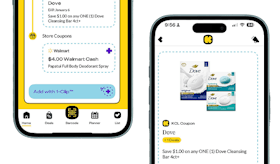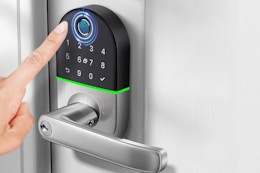For a lot of us, personal finance means budgeting the money we know we have coming in to ensure the necessities are covered. And that’s super important, but so is finding any way to squirrel even spare change away for the future. Every penny counts. Investing can feel like a lofty goal, and the lingo involved often looks like a foreign language. But it isn’t something that only applies to people who aren’t living paycheck to paycheck. Fortunately, there are digital tools aimed at simplifying investments, and right now Acorns Invest has a pretty big deal — a $20 credit after you invest an initial $5 (to use Acorns you’ll also have to sign up for a monthly subscription, which starts at $3).
Not familiar with Acorns Invest? Basically, it’s an investment app for everyday people. Acorns Invest helps you invest money for your future in ways that are so easy, you won’t even have to think about it. It doesn’t even matter if you have a small up-front investment. (You can literally invest spare change). And it’s a more accessible way to help you reach your financial goals for the future.
I know this stuff can seem intimidating, and you may have loads of questions. But don’t worry. I read the fine print so that you can be educated on exactly what you’re buying into. I’ll cover Acorns Invest and all of its portfolios, including Acorns Early and Acorns Earn, and everything in between.
Before I get started, be sure to download the KCL app or text HACKS to 57299 for more money-saving tips.
1. What is Acorns Invest?

Acorns’ flagship product is Acorns Invest. It allows you to invest as little as $5 at a time when you set up recurring contributions. There’s also an option to link Acorns with your bank account to “round up” your spare change.
For example, if you spent $79.23 at Target, Acorns would round up the difference to $80. That gives you $0.77 to invest without having to think about it.
Acorns Invest is a taxable account, which means you will be taxed on your earnings. It allows you to invest in portfolios full of ETFs. And if you’re more interested in your retirement plan, you can also check out Acorns Later. That’s more focused on helping you reach your retirement investment plans via automatic contributions.
2. Get a $20 credit when you first sign up with Acorns Invest.
But right now, The Krazy Coupon Lady has a special Acorns deal that gives you a whopping $20 credit after you invest an initial $5 in recurring investments. That’s pretty huge!
It costs $3 to use any of Acorns’ products every month. So this credit effectively covers your subscription fee for the first 13 months. (Or you could view it as free money to invest. Up to you.)
Related: What’s All the Hoopla Over I Bonds?
3. Acorns Invest offers tons of ETFs (Exchange-Traded Funds).
An ETF is a type of mutual fund. You can think of stocks like eggs and a mutual fund as a basket full of eggs. By having different eggs all in one basket, you’re automatically diversifying your investments. Then by having multiple baskets, you’re diversifying your investments even more.
Not all mutual funds or ETFs are created equally. Just because it’s diversified doesn’t necessarily mean it’s diversified well. Make sure to thoroughly research any ETF or mutual fund before you put your money into it. Or seek professional finance help.
There are tons of different ETFs available via Acorns. Depending on factors like your age, risk tolerance, and financial goals, Acorns will recommend a portfolio that’s made up of multiple ETFs. Join Acorns to find out which specific ETFs are included in your recommended portfolio.
4. Acorns Invest lets you invest in an ESG portfolio.

ESG stands for “environmental,” “social,” and “governance.” Some ESG portfolios might put more emphasis on the environment. Others might focus on gender equity at the corporate level. And still other alternatives might look at the social impact the company has in the communities in which they operate.
One good thing to think about any time you invest in something labeled ESG is that you might not support every company included in any given ESG ETF.
In the environmental space in particular, it’s pretty easy for huge companies to make themselves look green by purchasing carbon offsets. Again, different ETFs are going to have different standards. So if you do want ESG investing, you might have to do a little more research if you’re really, really dedicated to those values.
I’m not saying ESG investing isn’t worth it. It’s just important for you to go in with your eyes wide open.
5. Think twice before investing in Bitcoin.

Just because you can invest in Bitcoin doesn’t mean you should. Cryptocurrency is highly volatile, and its whole thing is that it’s unregulated. While you may like how punk rock it sounds, unregulated investments don’t provide you with any protection.
Do you know how Shaq and other celebrities are in trouble with the law right now for their involvement in FTX advertising?
Well, Taylor Swift became a personal finance hero when approached about an advertising deal with the company. According to Business Insider, she did it by asking one simple question:
“Can you tell me that these are not unregistered securities?”
They couldn’t, and she pulled out of the deal.
If she — the extremely rich daughter of a Merrill Lynch adviser — pushed the pause button, you should think about doing the same. While not all cryptocurrency came from FTX, this case example demonstrates just one of the many potential negative outcomes of investing in unregulated products.
To their credit, Acorns does recognize this risk and tries to hedge it in their Bitcoin ETF. First, your investments in the Bitcoin ETF can only make up a max of 5% of your portfolio.
And they don’t have you investing directly in cryptocurrencies. Instead, you’re investing in crypto futures. And that’s just a fancy way of saying the perceived future value of various cryptocurrencies.
Personally, I don’t feel compelled to invest in any cryptocurrencies. Or their futures. But your decisions are yours alone to make. And Acorns does give you the option.
6. Limit your taxes with retirement accounts.

There’s no way to completely avoid taxes (at least not simple enough to get into here). But there are ways to seriously limit your tax burden through tax-advantaged retirement accounts.
If you’re not already maxing out the tax-advantaged retirement accounts available to you, it usually isn’t a great idea to invest in a taxable account. So most people would want to start here.
Just because you don’t get a retirement account from your employer doesn’t mean you don’t have tax-advantaged investment accounts available to you. Whether or not you’re offered a 401(k), you can invest in IRAs.
The type of IRA will depend on your situation. Acorns offers 3 IRAs:
- Roth IRAs
- Traditional IRAs
- SEP IRAs
TIP: With Traditional IRAs, you may or may not get a full tax deduction for contributions depending on factors like your income level, your ability to access another retirement account at work, and your spouse’s ability to access a retirement plan through work.
Roth IRA
With a Roth IRA, your contributions won’t be tax-deductible on today’s tax return. But when you reach retirement and start making withdrawals, you won’t be taxed on any of the growth.
Another pro of Roth IRAs is that because you’re contributing money that’s already been taxed, you can withdraw your contributions at any time without penalty. Now, it’s generally not advisable to take out any of the money you’ve invested for retirement. And that’s whether there are fees or not.
But if it’s between taking out a 401(k) loan and withdrawing contributions from a Roth IRA, the Roth IRA withdrawal is a better option.
The fact that you can still access your money may also calm any anxiety you might have about locking money away that you can’t touch until retirement. A lot of Americans struggle to get by from paycheck to paycheck, preventing them from investing at all. The Roth IRA setup may help alleviate that mental hurdle.
If your investments earn returns, you won’t be able to touch those returns until retirement, except in select fee-incurring circumstances. But you should be able to access your original contribution at any time.
Traditional IRA
Traditional IRAs work almost the opposite way. If you contribute to a traditional IRA, you’ll get tax deductions on your tax return this year. This effectively lowers your taxable income, which could lower your overall tax. But note that it won’t lower your overall tax dollar for dollar.
But between now and retirement, your investments should (hopefully) grow. And when you make withdrawals in retirement, you’ll have to pay taxes on the withdrawals you’re making.
Some people like traditional IRAs because they think they’ll be in a lower tax bracket once they’re retired. This may or may not be the case for you, or the savings you get today may be negligible depending on your current tax bracket.
If you don’t know which one is best for you, it’s generally a good idea to sit down with a certified financial planner to figure it out.
TIP: The 2023 contribution limit for both Roth and Traditional IRAs is $6,500 (or $7,500 if you’re age 50 or older.)
SEP IRA
SEP IRAs work similarly to Traditional IRAs on the tax side. You’ll get a deduction for your contributions up front, but you’ll have to pay taxes on withdrawals in retirement.
However, there are no similarities when it comes to contribution rules. The “SEP” in SEP IRA stands for ‘Simple Employee Pension Plan.’ (Yeah, I dunno why it’s not SEPP either.)
This type of plan is run by an employer, so you’ll see a lot of self-employed people with them. But you can run one even if you own a big business. Only the employer contributes, but they can contribute up to 25% of each employee’s pay. This can mean up to $66,000 per year in 2023. (For the self-employed, you as the employer can contribute 25% of your net profit each year.)
Twenty-five percent can be a lot of money — a lot more than Traditional IRA contribution limits. It can have a meaningful impact both on your retirement goals and your taxable income in the here and now.
But remember that if your business ever expands, you’ll need to account for SEP IRA costs when making new hires, though contribution percentages are flexible from year to year. And any employees will be 100% vested from day one. This means if they leave the company, they take all their retirement savings with them.
7. Acorns Early offers a beginner-friendly approach to investing in your kid’s future.

Acorns Early is a UTMA/UGMA (or custodial account). It’s essentially a taxable investment account in your kid’s name. You can easily set up recurring investments on a daily, weekly, or monthly basis. And your child can start accessing the funds once they’re legally considered an adult. (This varies by location).
These funds can be used for anything from college tuition, college application fees, or even a new car. You also get access to expert financial advice, which is helpful for those new to investing.
But let me be honest. There are quite a few red flags with UTMA/UGMA accounts:
- They’re one of the most harmful things you could do to the FAFSA. If you ever think your child is going to be eligible for any financial aid for college, think long and hard before opening a UTMA/UGMA in their name. It’s a reportable asset and will be counted as the child’s own money, which has the highest percentage of negative impact on the amount of aid they could potentially receive. This is not true with a 529 college savings account, which is counted as a parental asset as long as it was opened by the parent with the child as the beneficiary.
- You’re going to get taxed on the growth. Unlike a 529 used to pay for educational expenses, you’ll be taxed on the growth of a UTMA/UGMA every year. There are certain tax advantages on the first portion of the unearned income since your child is under 18, but the account is still taxable.
- Your child gets full control once they come of age. When your child reaches the age of majority, they’ll be completely entitled to full control of every penny in the UTMA/UGMA account. You don’t get a say anymore. This is of particular concern if the money has grown the way you wanted it to. Some 18- and 19-year-olds make bad financial decisions when handed tens of thousands of dollars with no strings attached.
TIP: If your child is disabled, a 529A or ABLE account can shelter 100% of the money you save and invest for FAFSA purposes, even though the money is in their own name. The money can also be used for education or almost any other expense your child may incur as a disabled person.
New laws make 529s even more attractive.
It used to be that the big pro of UTMA/UGMAs was that you could use the money for anything you wanted. Meanwhile, 529 accounts could only be used to pay for educational expenses for the beneficiary (usually your kid). At least if you wanted to maintain the tax advantages.
But the SECURE 2.0 Act that passed in December 2022 changed things so that you can now roll over funds from a 529 into a Roth IRA. This starts next year and is subject to IRA contribution limits. So even if your child doesn’t go to school, you can still use your investments to benefit them in a tax-advantaged way. The money doesn’t just have to be for college.
On top of all this, if you have custodial accounts, your Acorns monthly fee goes up to $5.
That said, in select income brackets, a UTMA/UGMA may be a product you’re interested in. It’s just not for everybody.
TIP: Sitting down with a certified financial planner can help you figure out what your best long-term tax strategy is when it comes to UTMA/UGMAs.
8. There are pros and cons to Acorns Checking.
Aside from investing products, Acorns does also offer an FDIC-insured checking account. FDIC-insured accounts are insured for up to the first $250,000.
Here are some of the pros of Acorns Checking:
- Easily link to all of your Acorns investment accounts for Round Ups and other recurring contributions. (You can also do this with an outside bank account, but it’s still a tiny bit easier when everything’s all on one platform.)
- Can automatically funnel a portion of your money towards other goals, like an emergency fund.
- No minimum balance fees.
- No overdraft fees.
- Free access to AllPoint ATMs.
- All purchases are linked to Acorns Earn. (Which we’ll talk about in a second.)
And here are some of the cons:
- It only really makes sense if you’re already using one of Acorns’ investing products. Otherwise, you’ll be paying $3/mo just for the checking account. And you’ll miss out on a lot of the pros listed above.
- If you’re building an emergency fund or saving for some other goal, it’s going to be much more profitable for you to open a high-yield savings account. (At least at the time of writing this). These accounts are available at various financial institutions and are commonly paying over 4.00% APY. When you start saving thousands of dollars, this interest can be meaningful. Acorns Checking doesn’t pay interest.
- The minimum opening deposit is $25, which isn’t unheard of. But it’s more than it takes to get started with Acorns’ investing products.
9. Think of Acorns Earn like Rakuten for investing.

The final feature you could take advantage of with Acorns is Acorns Earn. Think of it like Rakuten for investing.
Every time you make a purchase through Acorns Earn (or with your Acorns Checking account), you’ll get a small amount chipped in towards your investment account. So instead of the money coming back to you via your PayPal like it would with Rakuten, it goes directly towards those bigger goals of tomorrow.
Download the KCL app to add and redeem coupons in store






























































































